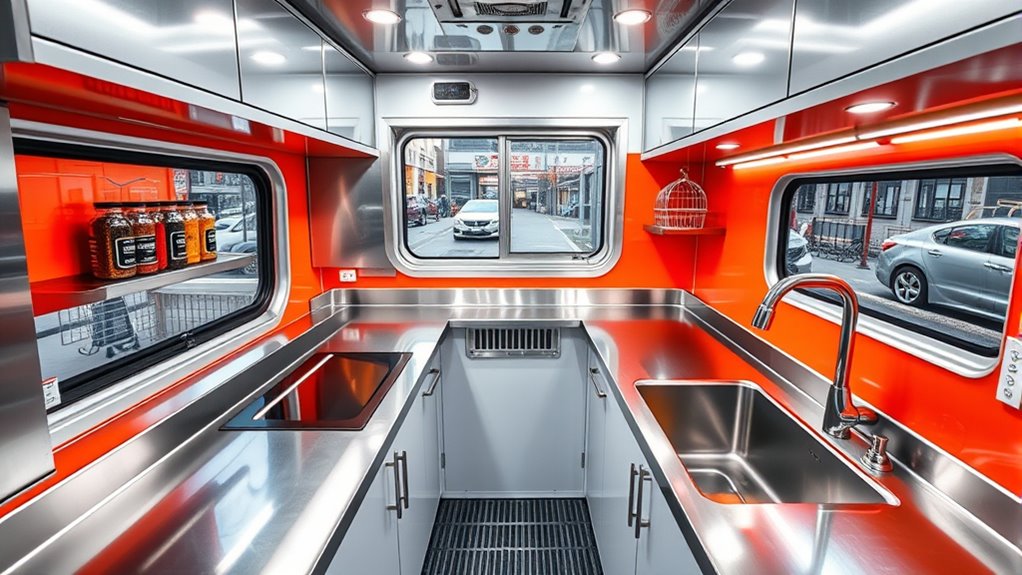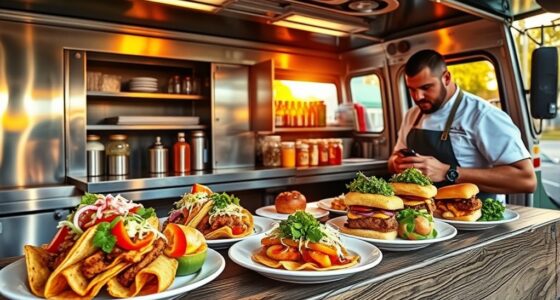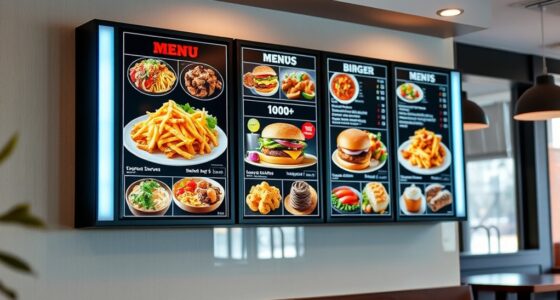To design an efficient food truck kitchen layout, start by evaluating your space and workflow needs. Plan appliance placement carefully to minimize movement and streamline food prep, cooking, and serving zones. Maximize storage with vertical solutions and organized shelving, keeping essentials within easy reach. Guarantee safety and compliance with ventilation, fire safety, and sanitation standards. Continuously test and adjust your setup for smooth operations. Keep exploring for expert tips to perfect your kitchen layout.
Key Takeaways
- Map out dedicated zones for prep, cooking, and serving to streamline workflow and ensure safety.
- Strategically position appliances near storage and prep areas to minimize movement and enhance efficiency.
- Incorporate vertical storage solutions and modular units to maximize limited space.
- Ensure proper ventilation and compliance with health and safety standards for a safe working environment.
- Conduct testing and gather staff feedback to refine layout, improve workflow, and optimize space utilization.
Assessing Your Space and Workflow Needs
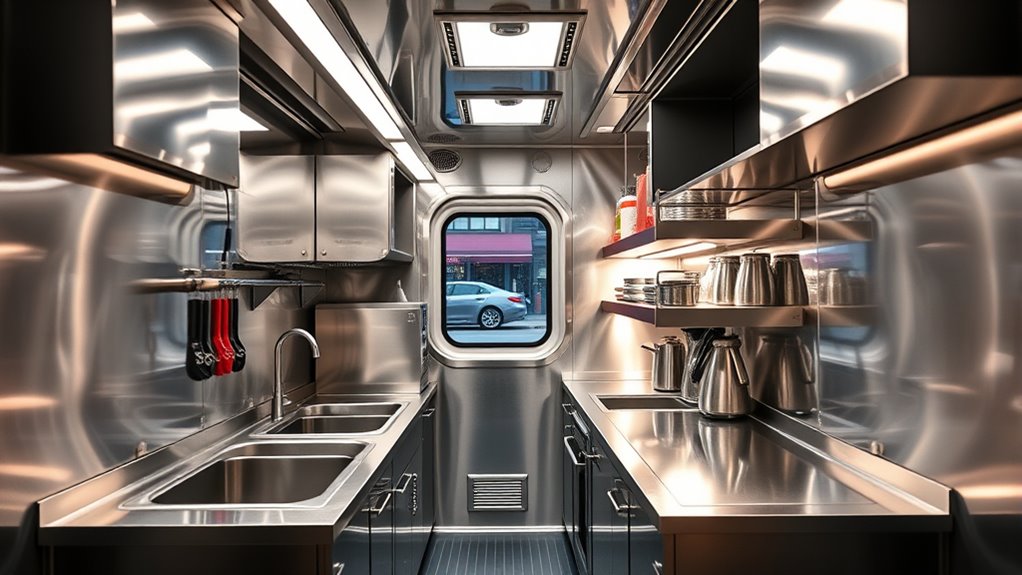
Before designing your food truck kitchen, you need to carefully evaluate your space and workflow needs. Consider how your menu customization options will influence your layout—if you offer diverse dishes, you’ll need designated prep and cooking zones. Think about how customers will interact with your truck to ensure branding consistency is reflected in your design, from signage to interior decor. Map out your workflow to streamline food prep, cooking, and serving, minimizing movement and avoiding cross-contamination. Prioritize essential equipment placement based on your menu’s requirements, and ensure there’s enough space for efficient movement. Understanding your kitchen layout and workflow will help you create a functional, cohesive kitchen that emphasizes your brand identity while supporting your menu flexibility.
Planning Appliance Placement for Efficiency

To maximize efficiency, you need to carefully plan where each appliance goes, considering your workflow and how you move through the space. Think about equipment accessibility so you can work quickly without unnecessary steps. Using space wisely guarantees your kitchen runs smoothly and minimizes clutter. Incorporating proper layout design can further optimize your workflow and enhance overall kitchen performance.
Workflow Optimization Strategies
Optimizing appliance placement is essential for creating an efficient workflow in your food truck kitchen. When you arrange appliances based on your menu customization, you streamline prep and cooking processes, reducing movement and saving time. For example, placing the grill near the prep station allows quick access for burger assembly, while positioning the fryer close to the storage area minimizes trips. Consider your marketing strategies too; a well-organized setup can enhance customer experience and boost sales. By thoughtfully planning appliance placement, you create a smooth, logical flow that minimizes bottlenecks and maximizes productivity. This strategic layout not only improves daily operations but also helps you adapt quickly during busy times, ensuring consistent quality and faster service for your customers. Incorporating kitchen efficiency techniques can further optimize your layout and workflow.
Equipment Accessibility Considerations
Ensuring that appliances are easily accessible is crucial for maintaining efficiency in your food truck kitchen. When planning appliance placement, consider your menu customization needs—placing frequently used equipment within easy reach speeds up prep and service. Think about vendor selection too; choosing reliable suppliers guarantees your appliances are durable and suited to your workflow. Arrange essential items like grills, fryers, and prep stations close together to minimize movement. Keep less-used equipment toward the back or higher shelves to avoid clutter. Accessibility also means considering electrical and gas connections, making sure appliances are positioned for safe, easy maintenance. Additionally, adopting vertical storage solutions can optimize space and improve overall organization. By thoughtfully planning appliance placement based on your menu and vendor options, you streamline operations and boost overall efficiency in your food truck.
Space Allocation Techniques
Effective space allocation begins with carefully planning where each appliance will go, so your workflow remains smooth and efficient. You want your kitchen to flow seamlessly, minimizing movement and maximizing productivity. Consider how your food truck decor and branding integration can influence appliance placement, creating a cohesive look that attracts customers. Incorporating layout optimization principles can further enhance functionality and visual appeal.
Creating Functional Prep and Cooking Zones
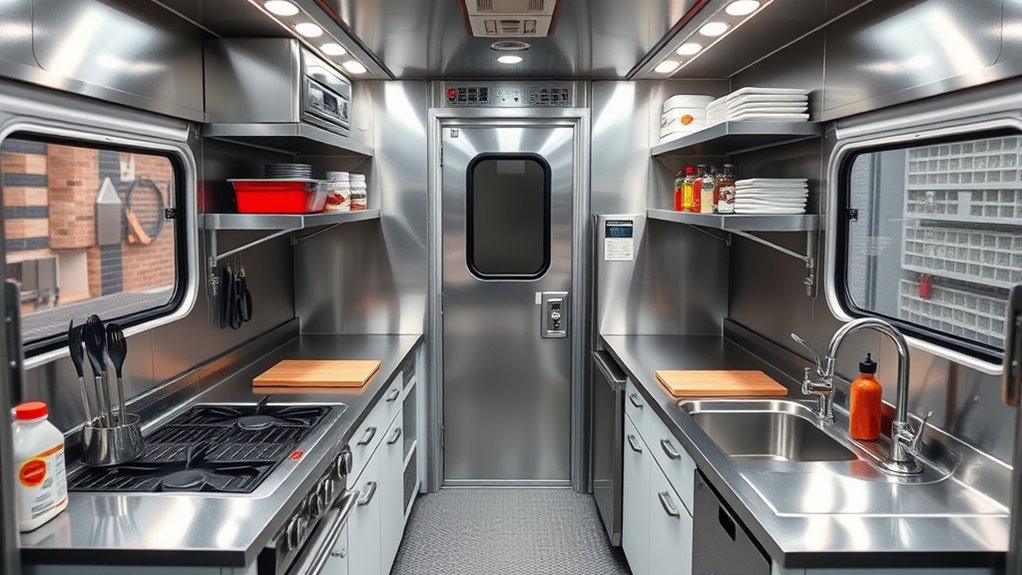
To create a smooth workflow in your food truck, it’s essential to design dedicated prep and cooking zones that are both functional and efficient. Clear separation helps streamline operations and keeps the kitchen organized. Consider how your food truck branding reflects your style and influences the layout, making your space memorable. Position prep areas near ingredients and tools for quick access, reducing unnecessary movement. Cooking zones should be adjacent but distinct, so multiple tasks happen simultaneously without congestion. Thoughtful layout also improves customer flow, allowing you to serve efficiently without bottlenecks. Keep in mind that a well-planned division of prep and cooking spaces enhances productivity and safety, ensuring your staff can work seamlessly while delivering a premier experience to your customers. Incorporating energy flow principles can further optimize the workspace for harmony and efficiency.
Maximizing Storage Solutions and Organization
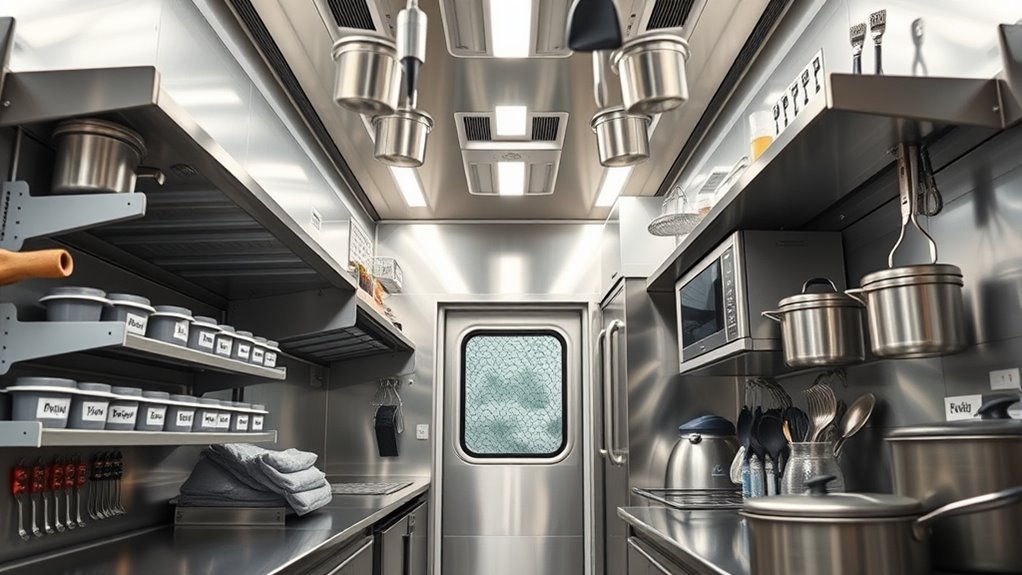
To make the most of your food truck’s space, focus on efficient cabinet design that guarantees essentials within reach. Vertical storage options, like wall-mounted racks and shelves, help maximize limited square footage. Implementing smart organization systems ensures everything stays tidy and accessible during busy service times. Additionally, incorporating hydrocolloid technology in storage containers can help keep ingredients fresh and reduce mess.
Efficient Cabinet Design
Have you ever wondered how a well-designed cabinet can transform your food truck kitchen? Properly planned cabinets maximize storage and keep your workspace organized, which is vital for food safety. Efficient designs include adjustable shelves for diverse equipment, sealed compartments to prevent contamination, and easy-to-clean surfaces. Incorporate ventilation systems within cabinets to reduce heat and moisture buildup, maintaining a safe environment. Well-placed cabinets also make it easier to access ingredients quickly, reducing cross-contamination risks. Remember, good ventilation systems help keep your kitchen air fresh and prevent odors. Utilizing store hours knowledge can help plan your shopping for the necessary materials and supplies efficiently. Focus on durable materials that withstand constant use and ensure secure closures to avoid spills. With thoughtful cabinet design, you’ll streamline workflow, enhance food safety, and keep your kitchen efficient.
Vertical Storage Options
Ever considered how vertical storage can transform your food truck kitchen? Utilizing wall-mounted shelves, hanging racks, and stacked bins helps you maximize limited space while reducing clutter. Vertical storage options keep frequently used tools and ingredients within easy reach, streamlining your workflow. By organizing items vertically, you free up countertop and cabinet space, making your kitchen appear more open and tidy. Plus, smartly chosen storage solutions add aesthetic enhancements, giving your food truck a professional, clean look. When you optimize vertical space, you not only improve efficiency but also create a more inviting environment for you and your staff. Implementing these options ensures your kitchen stays organized, functional, and visually appealing, all while making the most of every inch available. In addition, understanding the Sun’s energy can inspire you to incorporate sustainable lighting and power solutions into your design.
Smart Organization Systems
Smart organization systems take vertical storage to the next level by integrating innovative solutions that maximize space and improve workflow. By customizing storage with adjustable shelves and modular units, you can easily adapt to menu changes and streamline ingredient access. Incorporate branding into your organization—such as custom labels or branded storage containers—to reinforce your truck’s identity. These systems help keep your workspace tidy, making menu customization quick and efficient. To boost efficiency, consider:
- Using pull-out drawers for frequently used tools and ingredients
- Installing labeled bins for easy ingredient identification
- Incorporating branded signage and decals for cohesive branding
- Utilizing skilled organization techniques to optimize every inch of your limited space
Smart organization not only saves space but also enhances your overall service speed and professionalism, creating a memorable experience for your customers.
Ensuring Safety and Compliance in Design
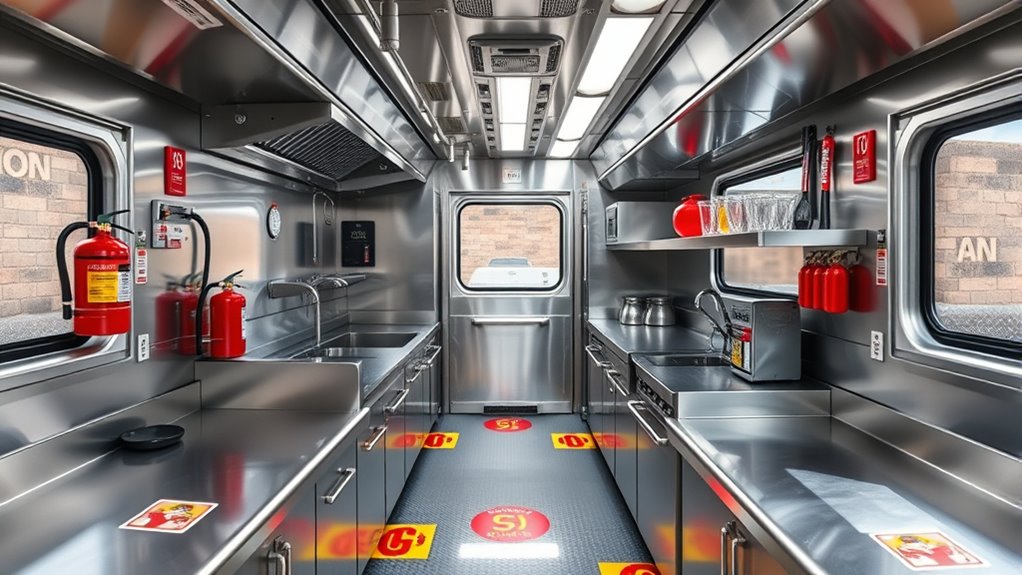
To guarantee safety and compliance in your food truck kitchen design, you must prioritize adherence to local health codes, fire safety regulations, and sanitation standards. Fire safety is essential; ensure you have proper fire extinguishers and fire suppression systems in place. Ventilation requirements are equally important, as adequate airflow minimizes smoke, heat, and fumes, reducing fire risk and maintaining a safe environment. Proper ventilation also helps meet health standards by controlling odors and preventing mold. Make sure your kitchen layout allows for clear evacuation routes and accessible safety equipment. Regularly review local regulations to stay compliant, and consider consulting professionals to verify your design meets all safety standards. Prioritizing these elements protects your staff, customers, and your business, especially considering the Ventilation requirements outlined in health and safety guidelines.
Tips for Testing and Refining Your Layout

Once you’ve designed your food truck kitchen with safety and compliance in mind, it’s important to test the layout in real-world conditions. This helps identify issues with ingredient storage, ventilation, and workflow. Start by preparing a few test runs to see how smoothly your team moves and how well equipment fits. Pay close attention to the ventilation systems—are fumes properly vented? Check if ingredient storage is accessible without clutter. Adjust placement based on these observations to improve efficiency. Incorporate proper ventilation techniques to ensure fumes and heat are effectively managed during operation.
- Try out different storage arrangements to optimize space and access
- Monitor airflow from ventilation systems during busy times
- Gather feedback from staff on flow and safety concerns
Frequently Asked Questions
How Can I Optimize Ventilation in My Food Truck Kitchen?
To optimize ventilation in your food truck kitchen, focus on proper exhaust fan placement to effectively remove smoke, heat, and odors. Install exhaust fans near cooking areas and ensure they vent outside, not into the truck. Use odor control strategies like activated carbon filters and proper air circulation techniques. Regular maintenance of your ventilation system maintains its efficiency, improving safety and comfort while maintaining a clean, odor-free environment.
What Are the Best Lighting Options for Small Kitchens?
Brighten your small kitchen with brilliant LED lighting options that deliver both efficiency and elegance. Task lighting is your top tool for targeting specific areas like prep counters or cooking zones, ensuring you see clearly and work safely. For a cozy, consistent glow, combine ambient lighting with focused task lights. By blending these lighting options, you’ll create a well-lit workspace that’s practical, pleasant, and perfectly suited for your food truck adventures.
How Do I Incorporate Sustainable Design Practices?
To incorporate sustainable design practices, you should choose recyclable materials for your kitchen surfaces and storage solutions, reducing waste. Opt for energy-efficient appliances to lower your energy consumption and carbon footprint. Additionally, consider installing proper ventilation to improve air quality and using LED lighting to save energy. These steps help create an eco-friendly kitchen that’s cost-effective and aligned with environmentally conscious values, making your food truck more sustainable and appealing to customers.
What Should I Consider for Accessible Kitchen Design?
Imagine a bustling kitchen where every movement flows smoothly, like a dance. You should consider accessible features that allow everyone to work comfortably, like wide aisles and lowered counters. Ergonomic arrangements are key, ensuring tools and appliances are within easy reach. By designing with accessibility in mind, you create an inclusive space that enhances efficiency and safety, making your food truck welcoming for all staff members.
How Can Technology Improve Kitchen Workflow Efficiency?
Technology can remarkably boost your kitchen workflow efficiency by integrating smart inventory systems and automated prep tools. With smart inventory, you’ll easily track supplies and reduce waste, saving time and money. Automated prep devices streamline repetitive tasks, allowing you to serve customers faster and focus on quality. Embracing these innovations makes your kitchen more organized, responsive, and productive, helping you stay ahead in a competitive food truck market.
Conclusion
By carefully designing your food truck kitchen layout, you’re not just creating a workspace—you’re crafting the heartbeat of your operation. Think of your space as a well-orchestrated symphony, where each element plays in harmony. When you optimize your workflow, storage, and safety, you set the stage for success. So, take the time to test and refine, turning your kitchen into a smooth-running machine that fuels your passion and keeps customers coming back for more.
